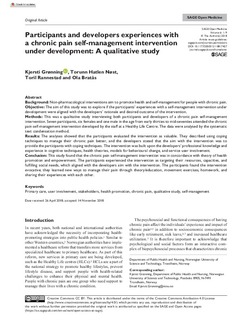| dc.contributor.author | Grønning, Kjersti | |
| dc.contributor.author | Nøst, Torunn Hatlen | |
| dc.contributor.author | Bratås, Ola | |
| dc.contributor.author | Rannestad, Toril | |
| dc.date.accessioned | 2019-03-05T07:49:59Z | |
| dc.date.available | 2019-03-05T07:49:59Z | |
| dc.date.created | 2018-12-10T14:03:24Z | |
| dc.date.issued | 2018 | |
| dc.identifier.citation | SAGE Open Medicine. 2018, 6 . | nb_NO |
| dc.identifier.issn | 2050-3121 | |
| dc.identifier.uri | http://hdl.handle.net/11250/2588620 | |
| dc.description.abstract | Background: Non-pharmacological interventions aim to promote health and self-management for people with chronic pain.
Objective: The aim of this study was to explore if the participants’ experiences with a self-management intervention under development were aligned with the developers’ rationale and desired outcome of the intervention.
Methods: This was a qualitative study interviewing both participants and developers of a chronic pain self-management intervention. Seven participants, six females and one male in the age from early thirties to mid-seventies attended the chronic pain self-management intervention developed by the staff at a Healthy Life Centre. The data were analysed by the systematic text condensation method.
Results: The analyses showed that the participants evaluated the intervention as valuable. They described using coping techniques to manage their chronic pain better, and the developers stated that the aim with the intervention was to provide the participants with coping techniques. The intervention was built upon the developers’ professional knowledge and experience in cognitive techniques, health theories, models for behavioural change, and service user involvement.
Conclusion: This study found that the chronic pain self-management intervention was in concordance with theory of health promotion and empowerment. The participants experienced the intervention as targeting their resources, capacities, and fulfilling social needs, which aligned with the developers aim with the intervention. The participants found the intervention evocative; they learned new ways to manage their pain through theory/education, movement exercises, homework, and sharing their experiences with each other. | nb_NO |
| dc.language.iso | eng | nb_NO |
| dc.publisher | SAGE Publications | nb_NO |
| dc.rights | Navngivelse 4.0 Internasjonal | * |
| dc.rights.uri | http://creativecommons.org/licenses/by/4.0/deed.no | * |
| dc.title | Participants and developers experiences with a chronic pain self-management intervention under development: A qualitative study | nb_NO |
| dc.type | Journal article | nb_NO |
| dc.type | Peer reviewed | nb_NO |
| dc.description.version | publishedVersion | nb_NO |
| dc.source.pagenumber | 9 | nb_NO |
| dc.source.volume | 6 | nb_NO |
| dc.source.journal | SAGE Open Medicine | nb_NO |
| dc.identifier.doi | 10.1177/2050312118817427 | |
| dc.identifier.cristin | 1641172 | |
| dc.relation.project | Norges forskningsråd: 238331 | nb_NO |
| dc.description.localcode | This article is distributed under the terms of the Creative Commons Attribution 4.0 License (http://www.creativecommons.org/licenses/by/4.0/) which permits any use, reproduction and distribution of the work without further permission provided the original work is attributed as specified on the SAGE and Open Access pages (https://us.sagepub.com/en-us/nam/open-access-at-sage) | nb_NO |
| cristin.unitcode | 194,65,20,0 | |
| cristin.unitname | Institutt for samfunnsmedisin og sykepleie | |
| cristin.ispublished | true | |
| cristin.fulltext | original | |
| cristin.qualitycode | 1 | |

